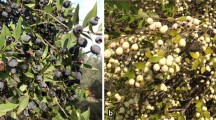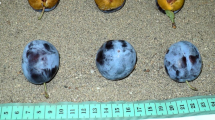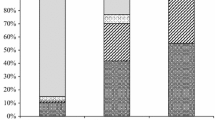Abstract
A newly developed red Chinese cabbage (Brassica rapa ssp. campestris; CC) was analyzed to determine the changes in functional compounds, especially in phenolic compounds. In the red CC, cyanidin was the major anthocyanidin, with 4.11 mg·g−1 dry weight (dw), while pelargonidin and peonidin were minor components. The control CC, however, contained no anthocyanidins. In both CCs, four hydroxycinnamic acids were detected, and sinapic acid was the principal compound found. Hydroxycinnamic acids in the red CC were significantly more abundant than were those in the control, by a factor of 1.4–13.3. Quercetin was the principal flavonol in the red CC, with 2.7 mg·g−1 dw, whereas it was the flavonol with the lowest concentration in the control CC (0.5 mg·g−1 dw). Kaempferol and isorhamnetin concentrations were also increased in the red CC by 1.41- and 3.10-times, respectively. The results imply that, due to the common synthetic pathways of the phenolic compounds, the creation of a red phenotype from the presence of anthocyanidin increased the levels of flavonols and phenolic acids. Pectin, reducing sugar, and cellulose levels in the red CC indicate that the red CC could be preferred by consumers because of its better taste. Consequently, the new red CC, by accumulating significant amounts of the bioactive anthocyanidin, has significant value for human nutrition.
Similar content being viewed by others
Literature Cited
Arapitsas, P. and C. Turner. 2008. Pressurized solvent extraction and monolithic column-HPLC/DAD analysis of anthocyanins in red cabbage. Talanta 74:1218–1223.
Bahorun, T., A. Luximon Ramma, A. Crozier, and O.I. Aruoma. 2004. Total phenol, flavonoid, proanthocyanidin and vitamin C levels and antioxidant activities of Mauritian vegetables. J. Sci. Food Agric. 84:1553–1561.
Bradford, M.M. 1976. A rapid and sensitive method for the quantitation of microgram quantities of protein utilizing the principle of protein-dye binding. Anal. Biochem. 72:248–254.
Chu, Y.H., C.L. Chang, and H.F. Hsu. 2000. Flavonoid content of several vegetables and their antioxidant activity. J. Sci. Food Agric. 80:561–566.
Ding, M., R. Feng, S.Y. Wang, L. Bowman, Y. Lu, Y. Qian, V. Castranova, B.H. Jiang, and X. Shi. 2006. Cyanidin-3-glucoside, a natural product derived from blackberry, exhibits chemopreventive and chemotherapeutic activity. J. Biol. Chem. 281:17359–17368.
Harbaum, B., E.M. Hubbermann, Z. Zhu and K. Schwarz. 2007. Impact of fermentation on phenolic compounds in leaves of pak choi (Brassica campestris L. ssp. chinensis var. communis) and Chinese leaf mustard (Brassica juncea coss). J. Agric. Food Chem. 56:148–157.
Harborne, J.B. 1989. General procedures and measurement of total phenolics. Academic Press, London.
Hu, K, Z. Zhu, Y. Zang, and S.A. Hussain. 2011. Accumulation of glucosinolates and nutrients in pakchoi (Brassica campestris L. ssp. chinensis var. communis) two cultivar plants exposed to sulfur deficiency. Hortic. Environ. Biotechnol. 52:121–127.
Hung, H.C., K.J. Joshipura, R. Jiang, F.B. Hu, D. Hunter, S.A. Smith-Warner, G.A. Colditz, B. Rosner, D. Spiegelman, and W.C. Willett. 2004. Fruit and vegetable intake and risk of major chronic disease. J. Natl. Cancer Inst. 96:1577–1584.
Iftikhar, S.Y., N. Washington, C.G. Wilson, I.A. Macdonald, and M.D. Homer Ward. 1994. The effect of pectin on the gastric emptying rates and blood glucose levels after a test meal. J. Pharm. Pharmacol. 46:851–853.
Imai, T., J. Sugiyama, T. Itoh, and F. Horii. 1999. Almost pure Ia cellulose in the cell wall of Glaucocystis. J. Struct. Biol. 127: 248–257.
Jiang, N. 2010. Phenolic compounds in Brassica vegetables in Korea. Chungnam National University, Daejeon, Korea.
Liu, R.H. 2003. Protective role of phytochemicals in whole foods: implications for chronic disease prevention. Appl. Biotechnol. Food Sci. Policy 1:39–46.
Maatta-Riihinen, K.R., A. Kamal-Eldin, P.H. Mattila, A.M. Gonzalez-Paramas, and A.R. Torronen. 2004. Distribution and contents of phenolic compounds in eighteen Scandinavian berry species. J. Agric. Food Chem. 52:4477–4486.
Manach, C., A. Mazur, and A. Scalbert. 2005. Polyphenols and prevention of cardiovascular diseases. Curr. Opin. Lipidol. 16:77–84.
Marks, M.M. 1949. Cellulose esters in the treatment of constipation. Am. J. Dig. Dis. 16:215–217.
Mattila, P. and J. Hellstrom. 2007. Phenolic acids in potatoes, vegetables, and some of their products. J. Food Compos. Anal. 20:152–160.
McDougall, G.J., S. Fyffe, P. Dobson, and D. Stewart. 2007. Anthocyanins from red cabbage-stability to simulated gastrointestinal digestion. Phytochemistry 68:1285–1294.
Miean, K.H. and S. Mohamed. 2001. Flavonoid (myricetin, quercetin, kaempferol, luteolin, and apigenin) content of edible tropical plants. J. Agric. Food Chem. 49:3106–3112.
Noda, Y., T. Kaneyuki, A. Mori, and L. Packer. 2002. Antioxidant activities of pomegranate fruit extract and its anthocyanidins: Delphinidin, cyanidin, and pelargonidin. J. Agric. Food Chem. 50: 166–171.
Prola, L., B. Dobenecker, and E. Kienzle. 2006. Interaction between dietary cellulose content and food intake in cats. J. Nutr. 136: 1988S–1990S.
Robards, K., P.D. Prenzler, G. Tucker, P. Swatsitang, and W. Glover. 1999. Phenolic compounds and their role in oxidative processes in fruits. Food Chem. 66:401–436.
Rochfort, S.J., M. Imsic, R. Jones, V.C. Trenerry, and B. Tomkins. 2006. Characterization of flavonol conjugates in immature leaves of pak choi [Brassica rapa L. ssp. chinensis L. (Hanelt.)] by HPLC-DAD and LC-MS/MS. J. Agric. Food Chem. 54:4855–4860.
Rose, D.J. and B.R. Hamaker. 2010. Overview of dietary fiber and Its Influence on gastrointestinal health, p. 185–222. In: T.M. Paeschke and W.R. Aimutis (eds.). Nondigestible carbohydrates and digestive health. Blackwell Publishing Ltd. and Institute of Food Technologists, Ames, IA, USA.
Sanaka, M., T. Yamamoto, H. Anjiki, K. Nagasawa, and Y. Kuyama. 2007. Effects of agar and pectin on gastric emptying and post prandial glycaemic profiles in healthy human valunteers. Clin. Exp. Pharmacol. Physiol. 34:1151–1155.
Siddhuraju, P. and K. Becker. 2007. The antioxidant and free radical scavenging activities of processed cowpea (Vigna unguiculata (L.) Walp.) seed extracts. Food Chem. 101:10–19.
Torres, C.A., N.M. Davies, J.A. Yanez, and P.K. Andrews. 2005. Disposition of selected flavonoids in fruit tissues of various tomato (Lycopersicon esculentum Mill.) genotypes. J. Agric. Food Chem. 53:9536–9543.
Vallejo, F., F.A. Tomas-Barberan, and F. Ferreres. 2004. Characterisation of flavonols in broccoli (Brassica oleracea L. var. italica) by liquid chromatography-UV diode-array detection-electrospray ionisation mass spectrometry. J. Chromatogr. A 1054:181–193.
Wu, X. and L. Ronald. 2005. Identification and characterization of anthocyanins by high-performance liquid chromatography-electrospray ionization-tandem mass spectrometry in common foods in the United States: vegetables, nuts, and grains. J. Agric. Food Chem. 53:3101–3113.
Yeh, C.T. and G.C. Yen. 2005. Induction of apoptosis by the Anthocyanidins through regulation of Bcl-2 gene and activation of c-Jun N-terminal kinase cascade in hepatoma cells. J. Agric. Food Chem. 53:1740–1749.
Author information
Authors and Affiliations
Corresponding authors
Additional information
These authors are contributed equally to this work.
Rights and permissions
About this article
Cite this article
Jiang, N., Chung, SO., Lee, J. et al. Increase of phenolic compounds in new Chinese cabbage cultivar with red phenotype. Hortic. Environ. Biotechnol. 54, 82–88 (2013). https://doi.org/10.1007/s13580-013-0136-5
Received:
Revised:
Accepted:
Published:
Issue Date:
DOI: https://doi.org/10.1007/s13580-013-0136-5




